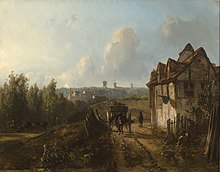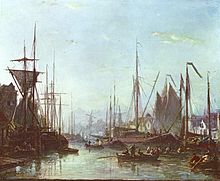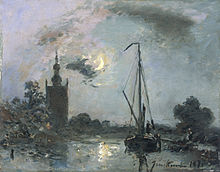Johan Jongkind
Appearance

Johan Jongkind (3 June 1819 – 9 February 1891) was a landscape painter of Dutch origin who painted in oil on canvas and in watercolor on paper - in France ànd in the Netherlands. He anticipated the plain-air innovations of Impressionism and was teaching in open air Boudin and Monet.
Quotes of Johan Jongkind
[edit]- sorted chronologically, by date of the quotes of Jongkind











- My specialty is really painting moonlight – but I will not forget the sunshine.
- Jongkind's quote in an early letter (1840's), to his Dutch friend Eugène Smits; as cited by nl:Victorine Hefting, in Jongkinds's Universe, Henri Scrépel, Paris, 1976, p. 69
- What I have suffered is unbelievable.. .I was given nothing [for his paintings in the Salon of 1855], not even a honorable mention.
- In Jongkind's letter from The Netherlands, 25 Nov. 1855; as quoted by Victorine Hefting, in Jongkinds's Universe, Henri Scrépel, Paris, 1976, p. 37
- I miss my friends in Paris. Holland is fine to paint, but Paris is the only place to follow one's studies. One can find judges there who will encourage you, who wil tell one what is necessary and what is missing. My great hope is to return as soon as the weather and luck are on my side for he journey.
- Quote of Jongkind in his letter, Oct. 1856 from The Netherlands, to Martin Beugniet in Paris; as cited by Victorine Hefting, in Jongkinds's Universe, Henri Scrépel, Paris, 1976, p. 46
- Martin Beugniet in Paris buys many new works of Jongkind and tried to persuade him to come back to France
- I have another painting finished, a view near Rotterdam, and then another in process, and very far along. I made them from nature, that is to say I made watercolors [in open air] after which I made my [oil]-paintings.
- In a letter to his Dutch friend Eugène Smits, 22 Nov. 1856; as quoted in Master Drawings from the Yale University Art Gallery, by Suzanne Boorsch, John Marciari; Yale University. Art Gallery, p. 246 - note 7
- Eight days ago I left Paris and here I am at Honfleur, the place to which I return, as always, with new pleasure. It is a little seaport where there are ten or twenty ships of all nations; not counting the fishing vessels of the same nations. I tell you that this is very interesting for my studies.
- In a letter, August 1865, describing his visit to Honfleur; as quoted by Moreau-Nélaton, in Jongkind, raconté par lui-même, 1918, p 88
- Jongkind visited Honfleur for the third time in his life, in the Summer of 1865 - staying at Isabey's farm at Sainte Adresse
Quotes about Johan Jongkind
[edit]- sorted chronologically, by date of the quotes about Jongkind
before 1900
[edit]- Monsieur Jongkind is a very fine Colorist. His slightly over-bright colors belong to him alone, his vividly sketched landscapes have great character, his paintings could be recognized among thousands. This is a fairly rare merit today. Monsieur Jongkind is opening up a very pretty part in art. It is not a royal highway, but where he walks by himself, without being elbowed out.
- Quote of Edmond About in 'the Salon of 1855'; as cited by Victorine Hefting, in Jongkinds's Universe, Henri Scrépel, Paris, 1976, p. 37-38
- You know that the only marine painter that we have, Jongkind, is dead to art. He is completely mad.
- Quote of Claude Monet, in a letter to Boudin, 20 Febr. 1860: as quoted in Johan-Barthold Jongkind, 1819-1891, by George Besson; Les Editions Braun et Cie, Louis Le Grands, Paris, p. 7.
- Later in 1860 Jongkind returned to Paris and met there Madame Fesser, who supported him, combined with the strong devotion of his circle of friends (Victorine Hefting, p. 49 [1])
- Jongkind's craft hardly concerns him; and this results in the fact that, before his canvases, it does not concern you either. The sketch finished, the painting completed, you do not trouble yourself with the execution, it disappears before the power of the charm of the effect..
- Quote of Jules Antione Castagnary in Salon des Refusés, 1863; as quoted in Cezanne and the End of Impressionism: A Study of the Theory, Technique, and Critical Evaluation of Modern Art, Richard Shiff, University of Chicago Press, 2014, p. 98 – 117
- With him [Jongkind] all lies in impression.
- Quote of Jules Antione Castagnary in Salon des Refusés, 1863; as quoted on the website Musée d'Orsay, 04-12-2017: Joan Barthold Jongkind [2]
- the critic Castagnary wrote these premonitory words in 1863, when Jongkind exhibited three paintings at the 'Salon des Refusés', including his 'Ruines du château de Rosemont' (Musée d'Orsay, Moreau-Nélaton donation)
- He works himself up into a frenzy, on order to make great strides, before returning to Paris.
- There at the moment in Honfleur.. ..Boudin and Jongkind are here; we get on marvelously.. .There's lots to be learned and nature begins to grow beautiful..
- One must be particularly knowledgeable in order to render the sky and the land with this apparent disorder, here [in Jongkind's art, showed at the Salon of 1868] everything is true (French: 'vrai').
- Quote of Émile Zola in 'Mon Salon, 1868'; ; as quoted in Cezanne and the End of Impressionism: A Study of the Theory, Technique, and Critical Evaluation of Modern Art, Richard Shiff, University of Chicago Press, 2014, p. 17 - note 119
- Jongkind is beginning to make us digest a kind of painting of which the hard outer skin hides an excellent and most tasty fruit. I too have profited by coming in the door which he already had forced, and I have begun, albeit timidly, tp present my seascapes..
..the longer one looks at his watercolors, the more one wonders how he does them! They are made from nothing and yet the fluidity and the density of the sky and clouds are reproduced with unbelievable precision..
..Nothing alters him, success, honours, fortunes, attacks or disdain. He sizes men up for himself; he knows that the disdained Corot is the master of landscape, that the insulted Monet will soon be the glory of his age; he knows how to assess the weakness in the art of Isabey or Troyon.- Quote of Eugène Boudin, in 'L'Art, XLIII', 1887; cited by Victorine Hefting, in L'Univers de Jongkind, Paris 1976, p. 60 [3]
after 1900
[edit]- [Jongkind].. ..his painting was too new and far too artistic to be appreciated in 1862 at his prices. Moreover, no one was as bad at making himself valued, as he was. He was a straight-forward and simple kind of man, who could hardly speak bad French and was very shy. But he was very outgoing that day [in 1864, somewhere around [[w:Le Havre| Le Havre] ]. He asked to see my sketches, invited me to come and work with him, explained the whys and wherefores underlining his work and thereby, completed the training that I had already received from Boudin. He became from this moment my true master and it [is] to him, that I owe the definitive training of my eyes.
- Quote from: 'Claude Monet par lui-meme' – interview by Thiébault-Sisson / translated by Louise McGlone Jacot-Descombes; published in 'Le Temps' newspaper, 26 November 1900
- One of the most precious gifts he [Jongkind] owed Schelfhout was his initiation to quick sketching after nature, rendering the full aspect of a landscape through a wash of summary colours over a nervous and solidly constructed drawing.
- In the biography on Jongkind in 1918, by Etienne Moreau-Nélaton; as quoted at the website of Musée d’Orsay, 04-12-2017: 'Johan Barthold Jongkind' [4]
- Schelfhout was a Dutch Romantic landscape-painter who stimulated his pupils like Jongkind to sketch in nature
- He painted them 'after life', but one has to agree on the definition of this phrase insofar as he was concerned. A painting by Jongkind 'after life' is not a straightforward copy of the motif he had settled on. It is the reproduction of the same subject treated through watercolour. His first sketch is a watercolour. It is with his watercolour brush that he captured directly the impression of nature
- In the biography on Jongkind in 1918, by Etienne Moreau-Nélaton; as quoted at the website of Musée d’Orsay, 04-12-2017: 'Johan Barthold Jongkind' [5]
- Jongkind was not a completely open-air painter like Monet was. In front of his subject, he executed watercolors rather fast and with mastery. He then used these pictures to make afterwards his oil-paintings in the studio
- One must not forget that Boudin had received lessons from a master, Jongkind, whose oeuvre, especially in the watercolors, is the origin along with Corot of what has been called Impressionism.
- Quote of Monet in a letter to Gustave Geffroy, 8 May 1920: Wildenstein 1974, -91, 4:405; as cited in: Master Drawings from the Yale University Art Gallery, by Suzanne Boorsch, John Marciari, Yale University. Art Gallery, p. 246 – note 5
- ..in 1863 [Jongkind] begins the most beautiful series of watercolors that exists in the world.
- Quote of Paul Signac, 1927, 130); as cited in: Master Drawings from the Yale University Art Gallery, by Suzanne Boorsch, John Marciari, Yale University. Art Gallery, p. 246 – note 8
- As he painted them [the sailing ships, in the harbor of Le Havre ] again that summer of 1865, Courbet and Whistler were his neighbours. At Deauville the robust Courbet reveled in swimming and was enjoying himself as usual. Whistler was with him. Courbet still spoke of him as his pupil, although Whistler had outgrown his influence.
- In: Eugéne Boudin, by Ruth L. Benjamin; Raymond and Raymond, Incorporated, 1937, p. 61
- He has spent his childhood near a small port [Vlaardingen, near Rotterdam ]. The boats on the quayside, the proud three-masters leaving their home waters to sail the seas have always haunted his imagination and fed his imagination.. .His views of the river w:Scheldt, near Antwerp, painted during his most colorful period, are among his most memorable works.
- Quote of nl:Victorine Hefting, in Jongkinds's Universe, Henri Scrépel, Paris, 1976, p. 25
- Also Paul Signac, who wrote a book about Jongkind, admired especially these colorful series watercolors of 1863
- Watercolor provides him with an autonomous art-form, and attracts him with a charm, of which he is fully aware, and because of this he prepares all the means necessary to capture on paper the beauty of values, whether they be questions of color or of balance.
- Victorine Hefting, in Jongkinds's Universe, Henri Scrépel, Paris, 1976, p. 30
- Jongkind divides his colors more and more, puts them in juxtaposition, and by about 1875 he is on equal footing with Sisley, and later with Seurat.
- Victorine Hefting, in Jongkinds's Universe, Henri Scrépel, Paris, 1976, p. 72
External links
[edit]- biography notes and dates of Jongkind, in the Dutch R.K.D. Archive, The Hague
- many free images of paintings, drawings and prints of Jongkind, in the Rijksmuseum, Amsterdam
- Jongkind's painting art in Musee d'Orsay, Paris
- a biography of Johan Jongkind with art-images


